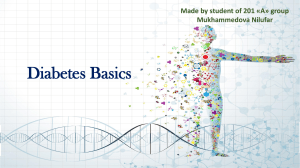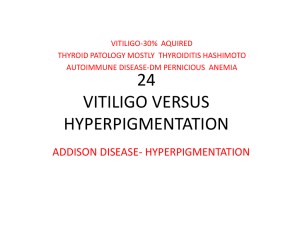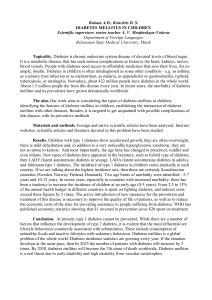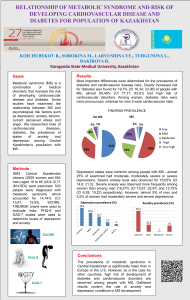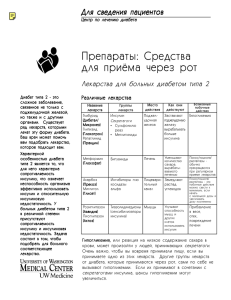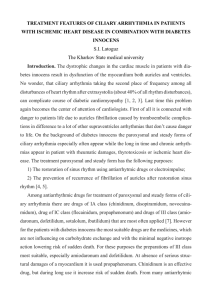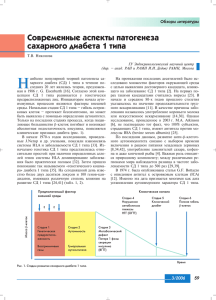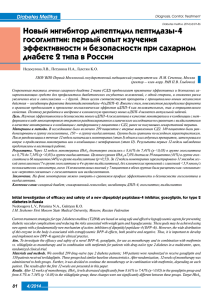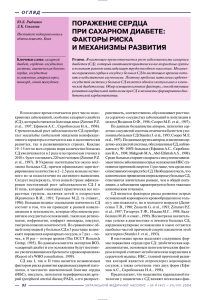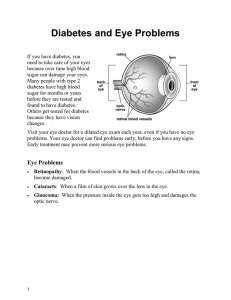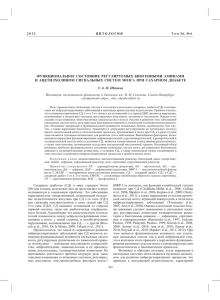использование инкретиномиметиков в лечении больных
реклама
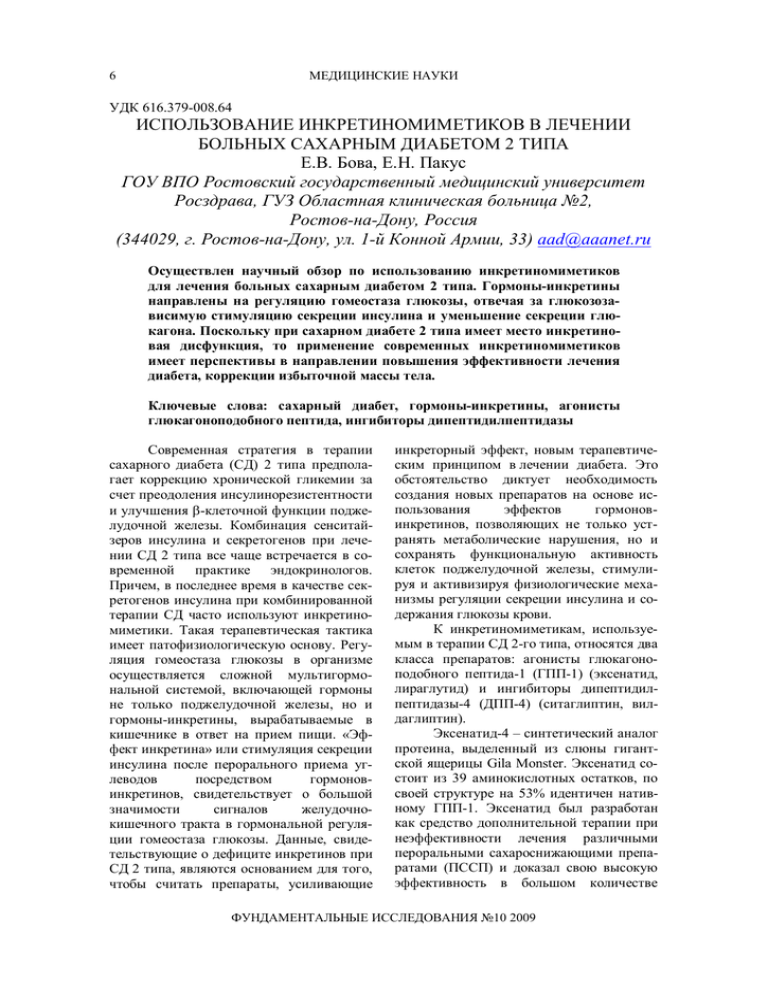
6 616.379-008.64 2 . , . , 2, , (344029, . , . 1- , 33) aad@aaanet.ru 2 . , . - 2 , , . : , , , , ( ) 2 . - . - . 2 , - , , , - . - , . . 2: -1 ( ) -4 ( ). , , , . « - , , - -1) ( -4) ( , -4 – , » 39 , 53% , . , - Gila Monster. - - -1. - 2 , , ( ) , 10 2009 7 - , [2]. 1- (0–10 2. (10–120 ), . ) , FDA ( ) 2 , , 1 [9]. , , , . . - , 2 10 , [8]. -4 ( - 80%), , -1 ( , ). - in vivo, . 28 , , , , , . 10 1,3 1,8 . - 90% , - . 2 -4 - -1 2,7 -4, [7]. , - . et al. (2005) [10]. , Scott R.S. - 12– 19% [6]. -4 « 2 , -4 -1, , - - , 7,8%, 0,77%. , 2 - » . -1 HbA1c. -4, , -4, . . - 2 ( -1), , , 2 8% - 18- . -4, , - 0,6%, 0,8% [10]. 24 – - , 10 2009 8 6,1 [4]. ), , 2 , ; - . • 2 521 2 , -b ( - – - ; • ) , , - , . , • - ; : - , . , 2 ( 2 ) ; - 1500 , • 4 50 : . , , ; , 1,1 , ; , , , . , . 100 2000 2008 - . -4 — 1 HbA1c 2 . 1 HbA1c 1,8%. (n=105; - - . - , , (n=147 1 ) - , 100 1000 , – 8,6%) 2 - HbA1c 1,7%. , . ( HbA1c - HbA1c n=96 1,4% ). 2 , 65 , 2- [3]. , , 100 1 (n=106) (n=50). 1 HbA1c 1,2% 2- 50-100 - , - . . . [1]: • 7% ( , 0,8% 2 2 [5]. -4 HbA1c , 10 2009 9 2 — - , . , - - - ( 1 -4), 2 , , . 1. ., . -IV - : 2 // : VI .- .- 2008.– .28-33. ., 2. . - : 2 // Consilium medicum. -2008. – .10. - 9. – .35-41. 3. Ahren B., Gomis R., Standi E., Mills D., Schweizer A. Twelve- and 52-week efficacy of the dipeptidyl peptidase IV inhibitor LAF237 in metformin-treated patients with type 2 diabetes // Diabetes Care. -2004. –Vol.27. –P.2874-2880. 4. Barnett A.H., Burger J., Johns D., Brodows R. Tolerability and efficacy of exenatide and titrated insulin glargine in adult patients with type 2 diabetes previously uncontrolled with metformin or a sulfonylurea: a multinational, randomized, open-label, two-period crossover noninferiority trial // Clin. Ther. -2007. –Vol.29. –P.2333–2348. 5. Dejager S., Lebeaut A., Couturier A., Schweizer A. Sustained reduction in HbA,, during one-year treatment with vildagliptin in patients with type 2 diabetes (T2DM) // Diabetes. -2006. – Vol.55. -Suppl 1: 29. 6. Edwards C.M.B., Stanley S.A., Davis R. Exendin-4 reduses fasting and postprandial glucose decreases energy intake in healthy volunteers // Am. J. Physiol. Endocrinol. Metab. -2001. –Vol.281. -N1. -E155–161. 7. Kim D., Wang L., Beconi M. (2R)-4oxo-4-[3-(trifluoro-methyl)-5,6-dihydro[l,2,4] triazolo[4,3-a]pyrazin-7(8H)-yl]-l-(2,4,5-triflu-orophenyl) butan-2-amine: a potent, orally active dipeptidyl peptidase IV inhibitor for the treatment of type 2 diabetes // J. Med. Chem. -2005. – Vol.48. –P.141-151. 8. Kolterman O.G., Buse J.B., Fineman M.S. Synthetic exendin-4 (exenatide) significantly reduces postprandial and fasting plasma glucose in subjects with type 2 diabetes // J. Clin. Endocrinol. Metab. -2003. –Vol.88. –P.3082–3089. 9. Qi D.S. Two year treatment with sitagliptin and initial combination therapy of sitagliptin and metformin provides substantial and durable glycemic control in patients with type 2 diabetes. // EASD Abstract August. -2008. –P412. 10. Scott R.S. Poster presented at the 41st Annual Meeting of the European Association for the Study of Diabetes (EASD), Athens, Greece. September 12–15 2005. –P.23. USE OF INCRETINES IN TREATMENT OF PATIENTS WITH DIABETES MELITIS OF 2nd TYPE E.V. Bova, E.N. Pakus Rostov state medical university, Regional hospital 2, Rostov-ON-Don, Russia (344029, Rostov-ON-Don, street of 1-st Horse Army, 33) aad@aaanet.ru The scientific review on use of incretines for treatment of patients with diabetes melitis 2 types is carried out. Incretines are directed on regulation of a homeostasis of glucose, being responsible for stimulation of secretion of insulin dependent on glucose and reduction of secretion of glucagon. As at diabetes mellitis 2 types take place incretines dysfunction application of modern hormones has prospects in a direction of increase of efficiency of treatment of a diabetes, corrections of superfluous weight of a body. Keywords: diabetes mellitis, hormones-incretines, a glucagon-like peptide agonist, a dipeptidyl peptidase-4 inhibitor. 10 2009
